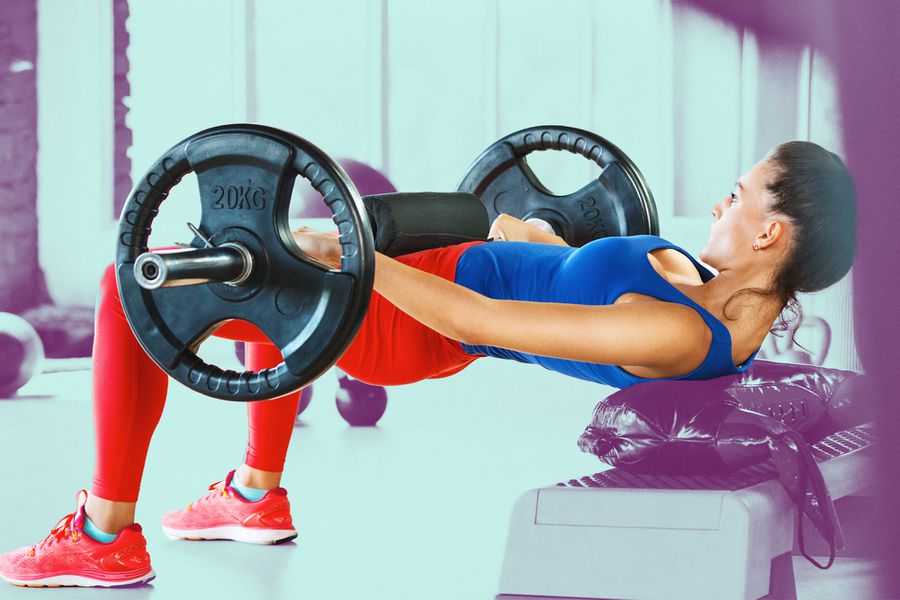
When you’re first attempting to perform hip thrusts as a strength-training newcomer, you might have a rough idea of how to position your shoulders on the bench and how to lift your booty up from the floor. The proper placement of your feet, however, may not be as intuitive.
Luckily, this genius hack on Instagram will help you learn the best way to position your feet in less than 10 seconds. The trick, shared and demonstrated by fitness trainer @studio.jibby, involves sitting with your shoulder blades resting against a bench and your legs fully extended in front of you. Then, you’ll place your fingers next to your “knee pits” (aka the shallow depression at the back of your knee) and slide your feet back so your heels are touching your fingertips.
This isn’t too good to be true, either. In fact, this form cue can be incredibly useful when you’re learning how to properly set up a hip thrust, says Kelly Froelich, a certified personal trainer and co-founder of the digital fitness platform Balanced. To effectively and safely perform the exercise, your feet should be placed slightly in front of your knees, she explains. And positioning yourself with this trick gets your feet exactly where they need to be — no guessing required, says Froelich.
And taking a few extra moments to correctly plant your feet is worthwhile, as their placement can have a major impact on the muscles the exercise activates, says Froelich. Reminder: Your glutes are the prime movers (aka the muscle group most responsible for the movement) during a hip thrust, but your quads, hamstrings, and adductors also turn on to help you complete the exercise. By placing your feet too far away from the bench or box, your hamstrings will take on more of the workload, while your glutes will do a bit less, says Froelich. Plant your feet too close, however, and you increase the pressure on your knee joints while you thrust upward, which puts you at greater risk of injury, she adds. “You want to have your feet an inch or half-an-inch in front of the knees so that you protect them but you’re still activating the glutes,” says Froelich. And this nifty fingertip trick can help you get that proper positioning, she explains.
Given the potential drawbacks of improper foot placement, Froelich recommends that anyone who is new to the hip thrust exercise incorporates this trick into their routine in order to master the form. "A couple of inches can really, really affect what muscles you activate, so if you're looking to get into hip thrusts, making sure your form is right is key," she explains. "And this hack is a really good way to check that."
That said, this technique doesn’t give you the full picture when it comes to hip-thrust foot placement. Generally, you’ll want to start with your feet hip-width apart to effectively target your gluteus maximus, but placing them slightly wider than that can fire up your gluteus medius, which sits on the side of your glutes, says Froelich. “If you put them closer together, you’ll still get that glute activation, and it’s actually good for helping with stability,” she explains. “It’s going to turn on your core more because your less stable — your base of support is smaller — and so you’re going to need a lot of core activation to keep your body in the plane of motion that you want it to go and from tipping over.”
The specific part of your feet — your heels or your toes — that’s supporting the majority of your weight also matters. “Digging your heels in activates your posterior chain, so it really activates your glutes, whereas, if you’re on your toes, it goes right to your quads,” says Froelich. “In a [conventional] hip thrust, you want to be activating the back of your body, so digging your heels in, even putting your toes up, is helpful to make sure you’re really focusing on the posterior chain.”
Even if your foot placement is on point, you won’t get all of the exercise’s booty-building benefits unless you have the hip mobility and core stability required to perform it safely and effectively, says Froelich. If your hips are tight, you won’t be able to achieve the full range of motion and you could be at risk for injury, she says. What’s more, not engaging your core — helping to keep it stable — throughout the exercise puts stress on your lower back, which can lead to back pain, she adds. Your Rx for success? Practice a few hip mobility exercises, core activation techniques (such as this resistance band hack), and then place your feet in their proper position before performing a hip thrust, she says. Trust, you’ll feel the difference after a single rep.






































